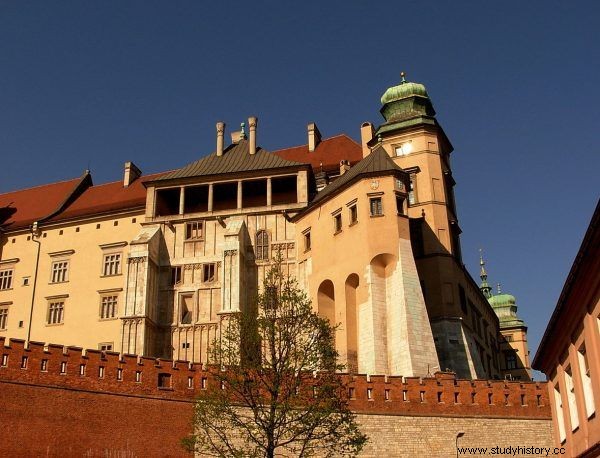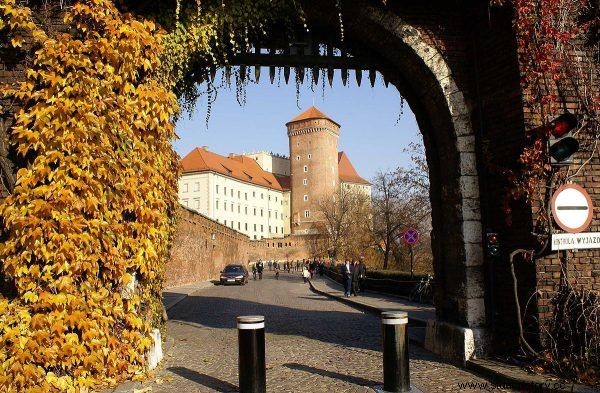When in the 16th century Henryk Walezy became the first elected king of Poland, two different cultures collided. The French monarch was surprised by many customs, as well as by the magnificence of the Renaissance royal residence at Wawel. The toilets and sewage system made a huge impression on him - a thing that was very little known in Western Europe at that time.
Meanwhile, the first Jagiellons, brought up in the Byzantine-Ruthenian culture, did not shy away from chastity, unlike their western neighbors. Jagiełło himself often used the baths. After the fall of the Western Roman Empire, this custom came back to us from the East.
Monarch on "Hen's Foot"
During the reign of this monarch, the "Crow's Foot" was erected on Wawel - the support of the eastern wing of the castle reaching beyond the actual walls. It housed, among other things, a medieval castle toilet. In this type of architectural solutions, dirt fell straight into the moat. The supports of the bay window (i.e. the ledge where the latrine was located) have survived to this day, but they come from later times.
We know that in the Middle Ages a passage also existed in the Senator's Tower, called Lubranka, built in the times of Kazimierz Jagiellończyk. This toilet is in a very good condition to this day. It is a stone slab with an opening covered with a board. Below is a vertical shaft approximately 8 meters long. The plank covering the toilet is probably a later convenience.

Hen's Foot on Wawel was built during the reign of King Władysław Jagiełło. And then the ruler went on foot there ...
Similar solutions to sanitary problems were often used by the Teutonic Knights, who called such bay windows or latrines "dansker", that is in Polish "gdanisko". The origin of this name is not entirely certain. Perhaps the name refers to the city of Gdańsk (in German:Danzig), which the knights of the Order sincerely hated, but probably the etymology is more ordinary and has to do with the German word "dannkehren" meaning "to remove outside".
Renaissance toilets
The real boom in cleanliness technology, however, took place after the Renaissance reconstruction of Wawel in the first half of the 16th century. First of all, the sewage system was constructed at that time. Water, which was very important in the castle not only for hygienic reasons, but also for defense and fire reasons, was drawn from the castle well. It was kept in special copper tubs placed on the floors of the castle. Traces of lead pipes of the water supply have been preserved here and there in the walls to this day.
Thanks to the bills from this period, we know that Jan of Dobruszko was responsible for the construction of the water supply between the foot of Wawel and the castle. He is referred to in the sources as "magister cannalium" or "pipe master". His duties also included maintaining all sewage installations in good condition. His profession at that time was called "water craftsmanship".
In the new Renaissance palace there were many toilets, i.e. small recesses equipped with toilets - wooden seats fastened with iron hooks. They were placed in the thickness of the wall and separated by doors. The vertical sewage system drained waste from there - some to special sewage pits, which we would today call a septic tank, and some to the sewers on the slope of Wawel Hill.
Panes with a cross-section of about 70 × 70 cm were made of brick; all had openings closed with brick arches. There were also sometimes small vents underneath them. Then the channel ran diagonally into the horizontal part, covered with a brick. Of course, the sewage pits had to be emptied from time to time, which involved a lot of work. Some of the preserved pits come from later times, because the remnants of earlier Renaissance facades were used to erect them.
The King's Private Outhouse
We know that there was one sewer on the southern slope - it was draining the sewage below the latrine in the Senator's Tower. The remains of the two remaining sewers were uncovered during excavations at the eastern facade of the eastern wing of the castle. However, it has not been determined which way exactly the sewage from the castle was drained outside the Wawel Hill area. Probably, just like the sewage from the royal kitchens, it ended up in Rudawka, and then in the Vistula.

The Senator's Tower is the second place in Wawel, where there were facilities for taking care of the needs ...
As you can see, there has been an underground sewage system in Wawel since the 16th century. Of course, not everyone used the toilet every time. The one in the bedroom of Sigismund the Old was most likely at the king's disposal. Some of the waste was carried out in vats - most of the courtiers and servants used potty pits.
Nevertheless, all this sewage system for Henryk Valois, originally from France, was a remarkable novelty. Such solutions were unknown in his homeland. Malicious say that the French courtiers used to settle down to fireplaces, as they did at home, because they did not know what the toilets were for. The fact is that Henryk Walezy, after escaping from Poland, ordered a sewage system to be introduced also at the French court.
***
This article was inspired by the book by Frances and Joseph Gies entitled "Life in a Medieval Castle" ( Horizon sign).
Bibliography:
- A. Fishinger, M. Fabiański, The history of building the Renaissance Wawel Castle around 1504-1548 , Volume I, Krakow 2009.
- M. Stępień, Architectural research of the facade of the Wawel Castle, in:"Studia Waweliana", vol. IX / X, Krakow 2000/2001, pp. 129-191.
- Achenburg, History of Dirt , crowd. A. Górska, Warsaw 2016.
